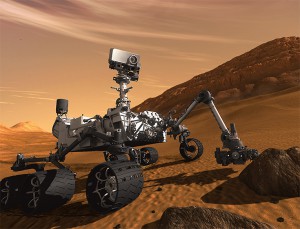
After traveling for 36 weeks from earth, and approximately 567 million kilometers (352 million miles), it was all down to the last 7 minutes to determine if the long travel was worth the wait.
By some called “7-minutes of terror”, the NASA Curiosity rover had to survive a complicated and intricate procedure to finally touch down on the surface of Mars. After months of waiting, now finally the scientists and engineers can breath a sigh of relief as the rover is securely seated on the surface of Mars.
The intense period called the entry, descent and landing (EDL) phase of the mission began when the spacecraft reached the top of the Martian atmosphere. At this time the Mars Science Laboratory spacecraft, carrying the Curiosity rover was traveling at about 5,900 meters per second (13,200 miles per hour). EDL ended about seven minutes later, with the rover placed stationary on the surface.
The NASA controllers, and the rest of the world, relied on NASA’s Mars Odyssey orbiter to provide confirmation of a successful landing. Odyssey was turned to the right direction before the landing procedure started so it could listen to Curiosity during the landing. The rover touched down on Mars at 1:31 a.m. EDT.
The Mars Science Laboratory spacecraft, carrying the Curiosity rover, was launched from Cape Canaveral Air Force Station, Florida, on Nov. 26, 2011. Curiosity is about 3 meters (about 10 feet) long, and five times as heavy as NASA’s previous twin Mars Exploration Rovers, Spirit and Opportunity, that was launched in 2003
Curiosity will carry the most advanced payload of scientific gear ever used on Mars’ surface, a payload more than 10 times as massive as those of earlier Mars rovers. The main objective of the mission is to assess whether the landing area ever had, or still has environmental conditions favorable to microbial life, both its habitability and its preservation.

The Mars Science Laboratory, and Curiosity was engineered and build by NASA’s Jet Propulsion Laboratory, Pasadena, Calif. It’s designed to roll over obstacles up to 65 centimeters (25 inches) high and travel up to about 200 meters (660 feet) per minute. The electrical power will be supplied by a U.S. Department of Energy radioisotope power generator. The multimission radioisotope thermoelectric generator produces electricity from the heat of plutonium-238’s radioactive decay, and this give the mission an operating lifespan of a full Mars year (687 Earth days) or more.
Unlike earlier rovers, Curiosity carries equipment to gather samples of rocks and soil, process them and distribute them to onboard test chambers inside analytical instruments. It has been designed to use radio relays via Mars orbiters as the principal means of communication with the Deep Space Network of antennas on Earth.
Spacecraft Specifications:
Cruise vehicle dimensions
(Cruise stage and aeroshell with rover and descent stage inside):
Diameter: 4.5 meters (14 feet, 9 inches )
Height: 3 meters (9 feet, 8 inches)
Rover dimensions:
Length: 3.0 meters(9 feet and 10 inches) not counting the arm
Width: 2.8 meters (9 feet and 1 inch)
Height at top of mast: 2.1 meters (7 feet)
Arm length: 2.1 meters (7 feet)
Wheel diameter: 0.5 meter (about 20 inches)
Mass total at launch: 3,893 kg (88,463 pounds) consisting of:
899 kg (1,982 pound) rover
2,401 kg (5,293 pound ) entry, descent and landing system (aeroshell plus fueled descent stage)
and 539 kg (1,188 pound) fueled cruise stage
Science payload: 75 kg (165 pounds) in 10 instruments:
- Alpha Particle X-ray Spectrometer
- Chemistry and Camera
- Chemistry and Mineralogy
- Dynamic Albedo of Neutrons
- Mars Descent Imager
- Mars Hand Lens Imager
- Mast Camera
- Radiation Assessment Detector
- Rover Environmental Monitoring Station
- Sample Analysis at Mars
